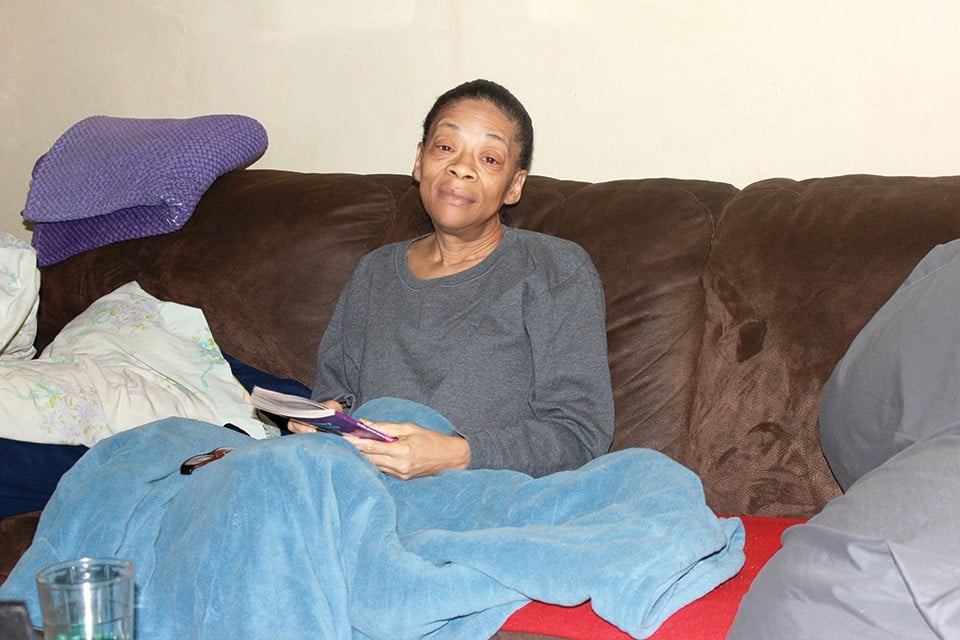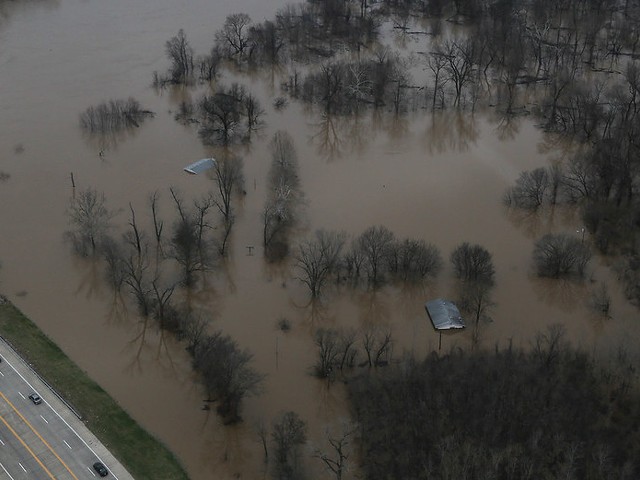On a balmy October day in East St. Louis, the sound of destruction hovers over the Lansdowne Towers. An excavator digs into the wrecking-ball-smashed facade of Brenton Tower, one of four high-rises that comprise the public housing development at 2901 Waverly Avenue. Perched on an electric lift, a crewman sprays water into the mass of shattered bricks, exposed metal cables and crushed glass, trying to keep down the dust. The thwack and crunch of the equipment rise into a grating cacophony.
In Apartment 408 of Rukavina Tower, the only building still inhabited, residents Eric Brown and RaChelle Stewart can't escape the noise. "That's the sound of what's going to happen to us," Brown says, pointing his finger toward the window.
Forty-five-year-old Brown is a slim, confident man who talks with his hands. Stewart, who is 52, watches him from their futon, nodding knowingly and interjecting occasionally.
When the couple moved to Lansdowne seven and a half years ago, most of the complex's 365 units were occupied. "There was a community here," Stewart says. "It was nice to have people around."
Then in May and June of 2017, Ruggeri and Brenton towers were emptied out by the Department of Housing and Urban Development, or HUD, which at the time oversaw the East St. Louis Housing Authority. The Starnes building followed in June of this year. The first two towers have been destroyed, and Starnes exists as a boarded-up shell. Brown, Stewart and all their neighbors in Rukavina have no choice but to wait for an order to leave that they know is imminent.
They have no concrete information about when that will happen and where they will go. The ESLHA is tight-lipped on the subject. By email, Executive Director Mildred Motley says that "the date has not been established" for Rukavina's destruction. "We will inform the residents before we establish the timeline for demolition," she writes.
The expectation of that day creates a palpable feeling of dread that covers Lansdowne like a shroud. "We're the last of the Mohicans," Brown says.

What's left of the Lansdowne Towers occupies an area of northeast East St. Louis. The tall brick buildings seem out of place amongst the overgrown lots and roughly paved streets. Many of the surrounding houses are abandoned. Stray dogs roam through the weeds.
The complex was built from 1965 to 1967, during the Lyndon B. Johnson administration. Until people began being displaced in 2017, Lansdowne was the largest public housing development in East St. Louis. For much of it's lifespan, it primarily housed senior citizens and people on disability.
East St. Louis is 98 percent African American, a demographic reflected by Lansdowne's remaining population. Many of the residents are elderly, but there are also some younger families with children. According to HUD, the tower was 96 percent occupied in 2017. The city, which has a median household income of $20,659, has a deep need for affordable, subsidized housing.
The housing stock, however, is severely damaged. Conditions at Rukavina are deplorable by any standard, including the housing authority's own. Reports originally obtained by The Southern Illinoisan from an August 2017 inspection of the Rukavina and Starnes buildings list a gobsmacking 201 health and safety deficiencies. Thirteen were deemed life-threatening.
The 130-page report details missing electrical breakers, broken smoke detectors, unlockable windows and doors, cracks in the foundation, badly clogged drains, leaks, exposed wires, units without refrigerators, damaged walls and ceilings, inoperable sinks, mold, mildew, water damage and blocked fire exits. Residents fear that the paint on the walls is full of lead.
Out of a possible 100 points, Lansdowne scored a seventeen, a failing grade by several miles. Incredibly, the report also states: "If all buildings and units were inspected, it is projected that a total of 590 health and safety deficiencies would apply to the property."
Motley, who was made executive director of the ESLHA toward the end of 2015, says the organization doesn't have nearly enough resources to make the needed repairs. "The systems were at or reaching the end of their useful life based on a green physical needs assessment conducted in 2015," she writes in an email. "The immediate needs for the development exceeded five million dollars and the total needs are in excess of thirty million dollars."
The economically savaged city doesn't have that kind of money. But since 25 percent of East St. Louis' 27,000 residents live in public housing, every closure is a hard hit to an already struggling community. A broken roof is still a roof.
That sentiment is echoed by many residents in Rukavina, who are appalled by their living conditions but feel like they don't have anywhere else to go.
"There are all kinds of problems here," Brown says, opening the door to his apartment one afternoon, bringing Stewart a soda from the corner store. Their place is squeaky clean — they make sure of that — but in dire need of maintenance. A window is damaged, requiring a stick to hold up the frame. The ceiling above their shower is crawling with mold.
Stewart greets Brown with a hug, and he settles into an armchair. A tiny television plays an episode of a game show. A picture of Brown from his time in the military sits on a nearby end table. In the photo, he looks bright-eyed, determined.
"I've been trying to get them to fix my bathroom for two years," Stewart says. She claims that management holds late rent over people's heads as a tactic to not perform maintenance.
"Our elevators go down all the time," she says, sipping her drink. Once, when the elevators stopped working, she ran into a neighbor sitting alone in his wheelchair. The man lived on the seventh floor and had no way to access his apartment. He spent all night in the lobby, waiting for a repairman who never showed up.
"That's a safety hazard," Stewart says. "You're supposed to be safe where you lay your head."
Stewart and Brown are originally from St. Louis and consider themselves Missourians. They feel isolated and displaced in Illinois. "We're a long way from home," Brown says.
Stewart doesn't like going outside because of rampant gun violence in the neighborhood. "When I moved in they told me it's not too dangerous over here. I'm saying to myself, 'How much more dangerous could it be?' I've seen somebody get shot dead right where I could look at him. I saw him on the ground."
"I heard gunshots last night," Brown says.
"Stray bullets don't have eyes," Stewart warns.
Brown and Stewart pay $284 a month for rent, a significant part of their income. About a year ago, Brown got a job loading trucks at a UPS warehouse in St. Louis. To make it to his 1 a.m. shift on time, he leaves at 11 p.m., walks ten blocks to the MetroLink and takes the train across the river. He likes the ride because it reminds him of when he used to live in St. Louis, which he still thinks of as home.
Brown repeats the trek when he gets off at 9 a.m. and returns home around noon, exhausted. He puts up with the five-hour commute because he hopes to be a delivery driver someday and his managers assure him they promote from within.
"It's dangerous to walk at night, but I try to wear black clothing to blend into the dark," Brown says. The lack of working street lights along the way aids his makeshift camouflage and makes him feel safer.
Brown and Stewart have been together for twelve years, through good times and bad. Eight years ago, a fire ravaged their house in St. Louis and they ended up on the street. Desperate, they sought temporary refuge at New Life Evangelistic Center, Reverend Larry Rice's notoriously controversial homeless shelter in the Downtown West neighborhood of St. Louis.
Though New Life, which was closed for building code violations in 2017, was a difficult place to live, it met a basic need for the pair at a low point in their life. "You had somewhere to go besides the street," Stewart says.
About this time, Stewart's daughter died of a drug overdose at the age of 23. When she speaks about her daughter, Stewart's voice trembles, on the verge of dissolving. "She's in a better place," she says, picking up a framed picture of the young woman in an ROTC uniform.
Beset by trauma, the couple bounced around, eventually finding themselves on the eastern side of the Mississippi River, applying for public housing. Originally, Lansdowne was supposed to be a stepping stone to something better. Over time, it became the only home they had.
Now that too will be taken away. Brown guesses they will have to leave in April of next year. The couple isn't sure of their next course of action.
Motley says that all of the residents will be relocated to other ESLHA housing unless they choose otherwise. She maintains that everyone who once lived in the other three towers was also afforded that opportunity.
Brown and Stewart have no choice but to wait and hope that they are offered a safe, clean place to live. "Doubt it," is Brown's succinct feeling on the matter.






